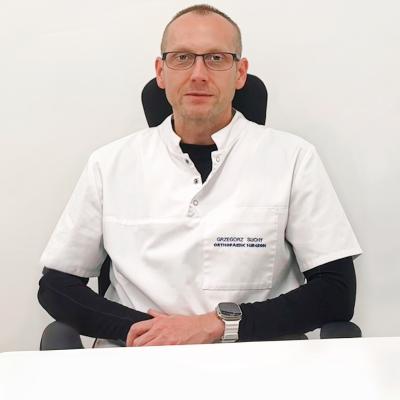Orthopaedic Surgeon
About specialty
Diagnosis and treatment of the musculoskeletal system conditions
What does an orthopaedic specialist do
Orthopaedic surgeon is a doctor whose area of interest is musculoskeletal system, i.e. ligaments, joints, muscles and bones, except for the skull. Orthopaedist deals with prevention and correction of posture defects, treatment of birth defects in children and mobility restoration in adults. Closely related to orthopaedics is traumatology which deals with the treatment (including surgery) of all kind of tissue and bone injuries after accidents.
Orthopaedic surgeon focuses on recognizing and treating posture defects, degenerative changes, inflammation of joints and bones as well as diseases of the ligament and joint system. His interests include neoplasms of the musculoskeletal system as well as metabolic and genetic diseases related to the osteoarticular system.
People of all ages become the orthopaedic surgeon's patients, as the defects of the locomotor system may arise in the prenatal period, develop in childhood or reveal themselves in adulthood.
When to seek help from orthopaedic specialist
Usually, we visit an orthopaedist when we are injured. Whether it's a strained tendon due to sports or a fracture due to a fall. The doctor should also examine us when we experience severe, long-lasting pain in muscles or joints. They might be caused by physical overexertion, but they may also indicate abnormal curvature of the spine, disease, and even cancer.
With children, it is recommended to consult a little patient already in the neonatal period. Thanks to a simple examination, doctor can confirm or rule out the existence of congenital abnormalities in the hip joints or clubfoot. In addition to birth defects, children are exposed to inflammation of joints or bones, postural defects (scoliosis, lordosis) and flat feet.
The elderly people are the largest age group visiting orthopaedic surgeon. In these people, the most common problems are degenerative and inflammatory changes as well as osteoporosis.
Scope of treatment
- congenital defects (torticollis, congenital hip dysplasia)
- posture defects (scoliosis, kyphosis, lordosis, flat feet, varus foot, hallux valgus)
- diseases of the spine (degenerative changes of the spine, discopathies, disc hernia)
- degenerative changes in the knee and hip joints
- physical overexertion and compression syndromes (tennis elbow, golfer's elbow, jumper's knee, heel spur, supraspinatus syndrome, carpal tunnel syndrome)
- inflammation of bones and joints (inflammation of costal cartilages, bursae, bones and bone marrow, tendons and tendon sheaths)
- injuries, including sports injuries (fractures, dislocations, sprains, e.g. of the femoral neck, patellar instability, meniscus injuries)
- foot deformity (valgus toes, hammer toes, chronic foot pain syndrome)
Recommended tests
During the first visit, orthopaedic surgeon asks the patient about past diseases and injuries. He also asks about current condition and orders additional tests if required. Type of examination depends on the patient's age and the type of problem the patient is complaining about. Sometimes additional tests are used to assess the condition of the skeletal system, to confirm or rule out the initial diagnosis.
X-ray and ultrasound scan examinations are the most frequently ordered additional tests.
Treatment methods
Treatment methods depend on the type of disease. Based on the interview and the additional tests, orthopaedist selects the best treatment method for the patient. Children with posture defects are usually referred for corrective exercises. For people with flat foot problem, it is recommended to wear appropriate, orthopaedic footwear. Drug treatment is used in degenerative and inflammatory diseases. Sometimes patients can be referred for physiotherapy. In other cases, doctor may recommend immobilization with a corset or a brace. In case of fractures, and sometimes dislocations and sprains, doctor recommends plaster or a fracture brace. A final, but sometimes the only form of treatment is surgery.

